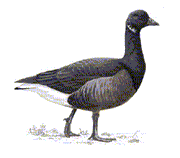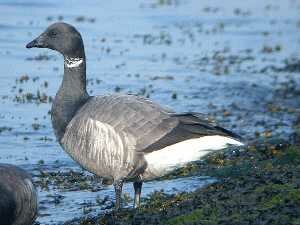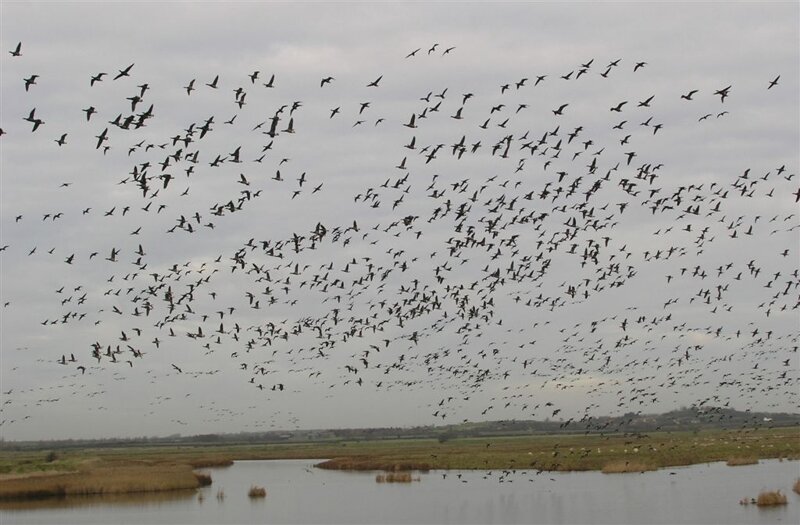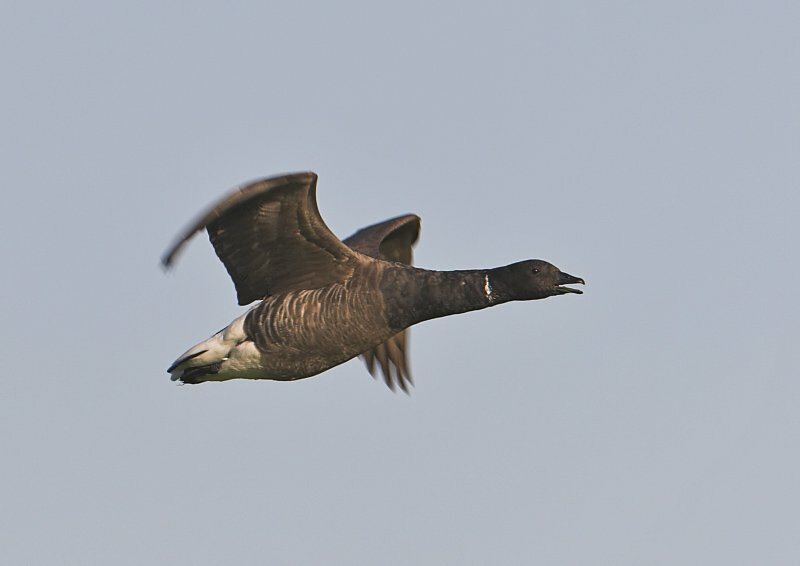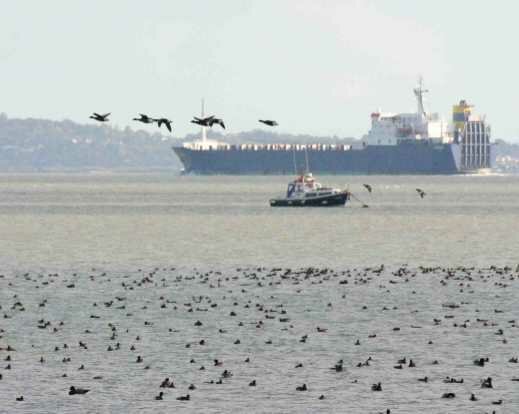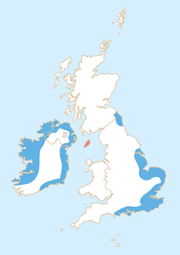The Brent Goose, Branta bernicla, is a rather small Goose between 55-60cm long (slightly bigger than a mallard), with a short neck and a weight of between 1.2-1.5 kg. Three subspecies of Brent Goose occur in Europe, of which two forms occur regularly in the UK. One of these subspecies, and our own bird, is the dark-bellied form (Branta bernicla bernicla). Neither form of the Brent Goose breeds here, rather they utilise the mild winter climate in the UK and Ireland to overwinter. Long distances are flown as the birds fly between their breeding grounds on the northern tundra of Russia. Both forms of the Brent Goose are comparatively rare in global terms. The pale-bellied form numbers around 20,000 in Ireland and 3,000 in Northumberland. The dark-bellied form found over wintering in the UK is believed to number up to 100,000 birds now, which equates to well over 30% of the global population. The Brent Goose is fully protected by the Wildlife and Countryside Act 1981, but provision is made for shooting under licence for the purpose of preventing serious damage to crops. The Department for Environment, Food and Rural Affairs (DEFRA) is responsible for issuing such licences in England.
Current Status in Essex: In 1997 the Essex population was estimated to be the following: Benfleet & Southend Marshes (3,819) Today, about 40% of the British population and around 16% of the global population of the dark-bellied brent Goose is thought to be present at peak times around the Essex coast. During September we scan the skies for our first sighting of Southend's own Brent Geese. Although the first flocks signify the oncoming winter they also give us an immense sense of pleasure in the knowledge that the Brent, the smallest of British wintering geese, have once again made their truly remarkable journey to grace our estuaries and fields again. A Year in the Life of our Brent Geese In March our Brent had moved inland from Two Tree island and were grazing the flat fields on Tollesbury Wick Marshes, a short flight but one which was to be the start of an incredible yearly journey. Triggered by the lengthening daylight hours and by rising spring temperatures, the geese flocks leave their Essex wintering grounds and head for Siberia. Flying at night and resting by day, the migrating geese will make leisurely progress in short stages through Holland. In places where the grazing is good they will linger for a week at a time. By May they will be in Denmark. Migrating wildfowl conserve energy by flying in the classic 'V' shape. Apart from the bird at the tip of the formation, every bird flies in the slipstream of the bird in front: it creates extra lift, and the bird uses less energy in maintaining speed and keeping station. On a journey of 3,000 miles conserving energy is a life or death matter. Older, experienced birds, who have made the journey in the past, take in turns the physically harder job at the tip of the arrow. The flocks will instinctively search for marshland, river deltas, coastal grassland and even farmland to rest and feed, before pushing on at dusk. They skirt the Baltic Sea to Lithuania, into western Russia. At Archangel, they are still only halfway with 200 miles before they cross the Arctic Circle into their true home, the tundra. With 1,500 miles to go. The geese pass over the tundra stretching to both horizons for day after day. It's barren, flat waterlogged; and even in early June, largely covered by ice and snow. Coastal tundra fringing the Arctic Ocean encircles the North Pole from Norway eastwards through Lapland, Russia, Asia, the United States and Canada. In Siberia, immense north flowing rivers - Yenisey, Lena, Ob and others - have created countless coastal islands, deltas and peninsulas. The Brent Geese from Essex finally drop down onto the largest - the Taimyr (also known as Taymyr) Peninsula, their birthplace. It is an immense and fearsome place, still locked in the last Ice Age. For man, beast and bird it is one of the most hostile environments on earth. Hundreds of miles inside the Arctic Circle, it is sheathed in ice and snow for most of the year: its coastline is sea ice. When the Brent geese arrive there is little green to be seen, but by late June the tundra has thawed and resembles a waterlogged sponge. Myriads of pools lie among the low, sedge-type vegetation with superb wild flowers like the Arctic poppy, glacier buttercup, Alpine dryas and purple saxifrage. Over 5000 square miles of Taimyr are zapovednik (preserved) for nature. Only a few hardy fur trappers and hunters share the tundra with 16 species of mammals, including Polar bear, Musk ox, lemming and over 500,000 reindeer. Fifty species of bird make great migration journeys to nest on the ground in the treeless landscape with the Brent geese. They include Red-breasted Goose, Grey and Golden Plover. The Arctic summer lasts just two months: August sees the first frosts of Autumn. In a short, frantic nesting season, young birds are aided by an explosion of insect life in the tundra pools and the 24 hours of daylight to make rapid growth; by a scarcity of human and natural predators, and by awesome amounts of empty space in which to roam. There is always a downside - breeding in the Arctic can be a huge success, or it can be an almost total failure. A poor Summer may fail to melt the snow. Winter could suddenly arrive a month early. Bird migration is behaviour that has evolved over great spans of time. For Brent geese to be still with us suggests migration for them and for many other species is a great benefit. Mortality on long journeys is great, but the survivors that breed are the strongest and the most adaptable, and those qualities are passed on to their offspring. Our RSPB members anxiously scan the flocks of Brent geese when they first arrive back from the Arctic during September. By identifying the young birds in their slightly different plumage we are able to gauge whether our geese have had a successful breeding year, we would hope that the flocks will have at least 25 to 30% young as an indication of success. With grateful thanks to Laurie Forsyth, Warden, Fingringhoe Wick Nature Reserve in the preparation of this article.
Identification A small, dark Goose - the same size as a mallard. It has a black head and neck and grey-brown back, with either a pale or dark belly, depending on the race. Adults have a small white neck patch. It flies in loose flocks along the coast, rather than in tight skeins like grey geese. It is an Amber List species because of the important numbers found at just a few sites. The complete summer moult begins in mid-July, the new flight feathers being fully grown-in between about the 10th and 15th of August. At this time the young are also already able to fly but have not as yet acquired their full plumage. Where does it live? The habitat most favoured by overwintering birds is muddy estuaries, adjacent salt marshes and pastures, and sandy bays. Brent geese feed and roost in tightly packed groups, also noticeable as they fly onto fields. As a flock they will fly low, fast and agilely. 1.7 Food is primarily eelgrass that may grow very abundantly in coastal estuaries. Green algae and marsh plants are also eaten, as are growing cereals. During the 1930s eelgrass, the primary food source, was infected with a wasting disease which dramatically reduced the hectarage of eelgrass beds. It is believed that the dark-bellied form of brent geese declined by at least 75% as a result. Breeding: Arctic tundra with shallow pools, usually near to the sea. Where to see it Locally at Two Tree island from the end of September through to March also at The Fleet, Wakering and Wakering Stairs. Conservation concerns: While not threatened in their breeding grounds, Brent geese do face pressure in the areas in which they winter. This is largely due to pressure on estuaries from development, pollution and recreational activities. The disappearance of eelgrass led to the population of this goose declining from the early 1930's until the 1950's. In 1958 the global population was estimated to be only around 16,500 birds. However, due to a gradual recovery of the eelgrass, a greater reliance on coastal grassland and cultivated cereal crops, and an increase in international protection the global population is now though to be around 215,000 birds. It appears that the numbers of overwintering brent geese feeding at Two Tree Island are increasing gradually, in line with a general global increase in the population of this species. The disappearance of the eelgrass in the 1930s because of disease led to a dramatic decline in the population of this species. The environmental causes of the disease and how it was triggered are still not fully understood. Other Local Concerns:
What does it eat? Vegetation, especially eel-grass. They may also feed on cultivated crops, such as wheat, oilseed rape and barley. Vital Statistics Eggs: 3-5 The WWT have also have a satellite tracking project of the Irish Light-Bellied Brent Geese which migrate to breed in Northern Canada and this article from the BBC illustrates just how fraught with danger these flights can be:
Conservation and targets Conservation organisations, such as the RSPB, have opposed developments to estuaries which threaten Brent geese. Conservationists work closely with other estuary users to ensure a safe haven for the geese. Where they cause problems on farmland, alternative feeding sites have been found. Did You Know?: The generic name Branta comes from a Norse word for burnt and refers to the black colour of the birds, which separates them from the grey geese. The word brent is derived from a Norse word brand, meaning burnt. The official name of the breeding area is (-) (Tai~myrskii~ (Dolgano-Neneckii~) avtonomnyi~ okrug), making the short name Taimyr a whole lot easier! Click here for details of the Gulls of Southend |
Page last updated:
Web Design Graham Mee. © Copyright of all pages South East Essex RSPB Local Group. All images copyright of owners
The Royal Society for the Protection of Birds. Registered charity no 207076
Please read our cookie, privacy and visitor policy
Translate this page: 





